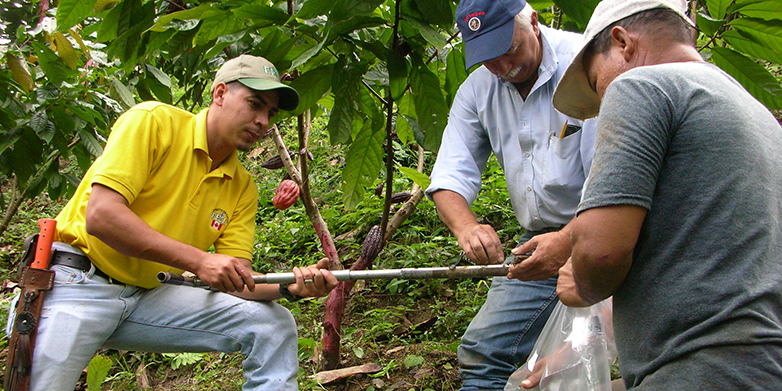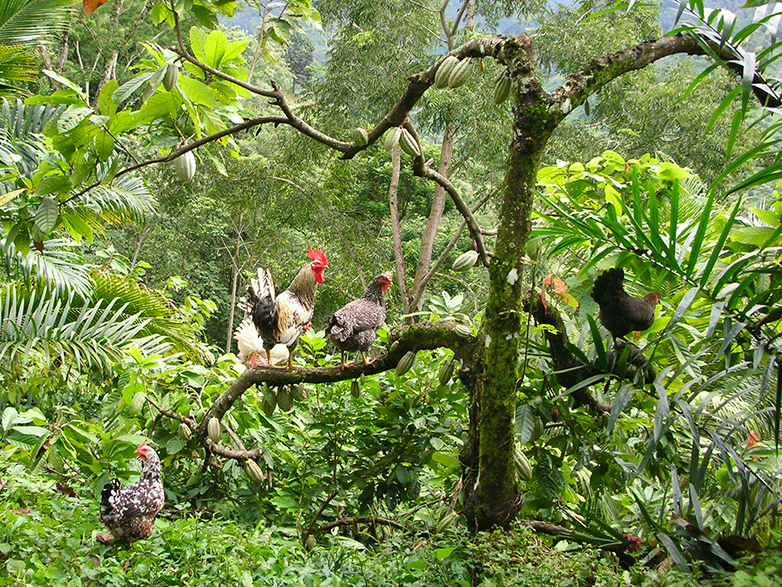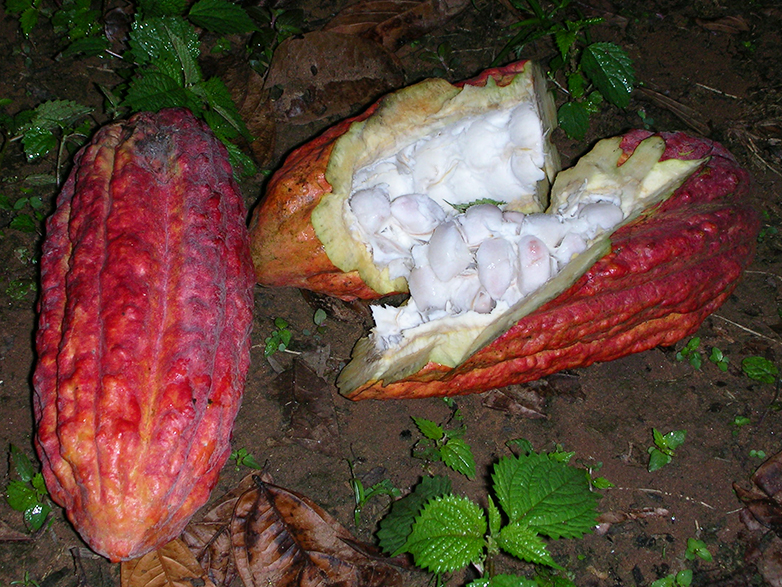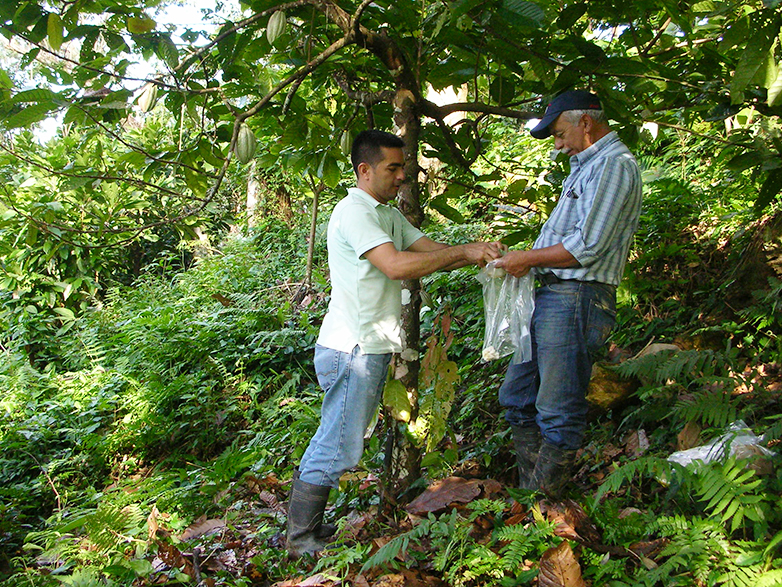Cadmium, cocoa beans and chocolate
Cocoa from Latin America tends to show higher cadmium levels than cocoa from other growing areas. ETH researchers have been investigating the underlying cause in Honduras and Bolivia.

A few years ago, the press picked up on worrying reports by German scientists that dark chocolate can sometimes contain significant amounts of cadmium, a poisonous heavy metal. Cocoa beans from Latin America are particularly affected. It was claimed that regular consumption of dark chocolate with a high cocoa content could possibly result in consumers absorbing significant amounts of cadmium into their bodies over the years.
The European Union has responded to these findings by announcing the introduction on 1 January 2019 of limits on the amount of cadmium in cocoa products. From that date, a 100g bar of dark chocolate containing more than 50 percent cocoa solids must not have more than 0.08mg of cadmium.
These upper limits could pose a serious threat to many smallholder farmers, for whom cocoa is the main source of income. But they also present a challenge to chocolate producers. “Excessive cadmium levels in cocoa are particularly problematic for retailers of organic chocolate, as their quality standards are based on even lower thresholds,” explains Professor Rainer Schulin from the Soil Protection Group at ETH Zurich’s Institute of Terrestrial Ecosystems.
This prompted the professor to launch a project in 2014 to investigate the problem of cadmium contamination in Latin America, focusing especially on Honduras and Bolivia. The project is being conducted in cooperation with the Research Institute of Organic Agriculture (FiBL) and with funding from ETH Zurich’s World Food System Center (WFSC).
Floodplains particularly affected
The results of the study, about to be presented at the first symposium of ETH Zurich’s World Food System Center, show considerable variation in the amount of cadmium contamination of the soil (and uptake in cocoa beans) in Honduras. Professor Schulin’s collaborator on the project, postdoctoral researcher Anja Gramlich, discovered raised cadmium levels in floodplains and volcanic soils. Contamination was much lower in samples taken from other areas.
The total cadmium content averaged 0.3mg per kilogramme of soil – comparable with the level occurring naturally in Swiss soils. Soil is classified as contaminated when it contains 0.8mg or more of cadmium per kilogramme of soil.
If elevated levels of cadmium were available to plants in the soil parent material, there was also a high uptake in the cocoa beans. Unusually, the researchers found significant amounts of cadmium in the soils and beans of some remote hilly regions well away from polluting industry and intensive farming. Most plantations are only managed as agroforestry estates with minimum use of artificial fertilisers or pesticides, both of which can be sources of cadmium pollution.
The researchers were therefore able to rule out farming methods as being responsible for raising cadmium levels in the soil. “We have no concrete proof that the problem is man-made,” confirms Dr Gramlich. “The cadmium seems to stem almost exclusively from the parent bedrock.”
Soil parent material binds the cadmium
The situation is different in Bolivia, where researchers did find some places with higher cadmium levels in the soil, but not in the cocoa beans on the trees growing on this soil. Dr Gramlich’s explanation for this phenomenon is that the soil samples tested in Bolivia were less acidic than those tested in Honduras. The amount of clay and organic material contained in the soil also plays a role. “Both of these bind cadmium, thereby reducing its uptake by the cocoa tree.”
It is still unclear whether the variety of cocoa tree grown affects the cadmium uptake in the beans. Investigations, including genetic tests, are currently underway to establish this. Not until this research has been completed will it be possible to recommend certain types of cocoa tree for planting on soils with elevated cadmium levels, according to Dr Gramlich.
Is the soil parent material the problem?
Cadmium occurs naturally in the ground, but also enters the soil through intensive farming or atmospheric pollution. “Previous data from Latin America were not conclusive enough to accurately identify the factors responsible for the high level of cadmium in certain soils and beans,” stresses Professor Schulin. “We therefore first had to collect some solid data in order to identify the relationships between cadmium uptake in cocoa trees and the farming methods used or the underlying geological bedrock.”
Dr Gramlich has been busy collecting this data through field trials in cocoa plantations in Honduras and Bolivia. She has collected and analysed soil samples, along with parts of the cocoa tree such as roots, leaves and beans.
Back in the laboratory, the ETH researcher measured not only the cadmium content, but also the acidity of the soil samples (cadmium is more available to plant uptake in acid soil), as well as the quantity of organic material and phosphorus. In addition, she analysed the two trace elements zinc and iron in the plant samples. The recorded levels were then compared with the total cadmium content in the cocoa beans.
Contaminated cocoa leads to loss of earnings

Cadmium contamination in cocoa beans can become a financial problem for smallholder cocoa growers, as they earn less money for their end product. It forces them to sell their beans to large wholesalers who produce cheap bulk goods, rather than high-quality chocolate. Major chocolate producers such as Mars are able to keep down the cadmium content in their products by purchasing cocoa beans from a variety of growing regions.
It is still unclear how farmers can effectively reduce or prevent elevated cadmium uptake by their cocoa trees. One simple procedure when establishing new plantations would be to check the cadmium content of the soil before planting any cocoa trees. If the levels are too high, another cash crop, such as coffee, could be grown instead.
Another approach is to add lime to the soil. In a trial carried out in Peru, the researchers have added lime to the soil surrounding the cocoa trees. This reduces the acidity of the soil, and with it the availability to plants of the heavy metal cadmium. In an initial test this measure did in fact reduce the chemical availability of cadmium in the soil. “However, we have not yet been able to verify any effect on the cocoa beans themselves. The time frame was still too short for that,” explains Professor Schulin. The beans take at least six months to mature. “Unfortunately we have been unable to carry out any further sampling on the test site for safety reasons that have nothing to do with the actual field trial.”
Even so, the professor does not think it necessary for people to avoid chocolate due to the cadmium risk. This heavy metal is found in cereals and vegetables as well. Smokers also absorb substantial amounts of cadmium from tobacco – up to half the threshold recommended by the World Health Organization (WHO). “Compared to our everyday uptake of cadmium with daily food, a treat with a piece of dark chocolate is no problem,” says the professor.
This research project has been funded by the WFSC Coop Research Program.
First symposium of the World Food System Center
The first symposium of ETH Zurich’s World Food System Center is being held on 4 November 2016. Researchers will be presenting projects undertaken over the past years as part of the first round of funding provided under the WFSC Coop and Mercator research programmes. In addition to the six presentations, there will be a poster session with updates on current findings. Entry is free, although prior registration is necessary under external page http://bit.ly/2eL4cRL.
2016 WFSC Symposium, 4 November 2016, 5.30-8.15 p.m., ETH Zurich Main Building (HG E1.2), Rämistrasse 101, 8092 Zurich


Comments
No comments yet